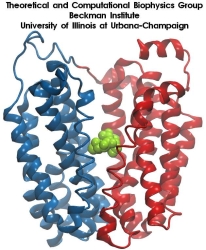Highlights of our Work
2025 | 2024 | 2023 | 2022 | 2021 | 2020 | 2019 | 2018 | 2017 | 2016 | 2015 | 2014 | 2013 | 2012 | 2011 | 2010 | 2009 | 2008 | 2007 | 2006 | 2005 | 2004 | 2003 | 2002 | 2001

image size:
215.8KB
made with VMD
Escherichia coli are bacteria living in the intestines of mammals as
part of their healthy gut flora, but also causing disease outside of the gut. The
bacteria import from their environment nutriments, for example molecules of
lactose, a sugar. For this purpose Escherichia coli employs in its
cell membrane a protein channel, lactose permease, that translocates
the sugar outside-in. This is the bacterium's "sweet tooth". To establish
the unidirectional sugar transport, the bacterium utilizes an
electrical potential maintained in the form of a trans-membrane
proton gradient (more protons on the outer cellular than on the inner cellular side of the membrane).
Protons, very small ions, that enter the channel from the outside
one at a time, open the outer channel entrance. This permits
access of lactose that gets bound inside the channel. Release of the
proton to the cell interior closes the outer channel entrance and
opens the inner channel entrance, such that the bound lactose can
enter the cell. Despite extensive and elegant
biochemical studies, the physical mechanism that couples unidirectional
proton and sugar translocation is not yet known in detail. A crystallographic
structure of lactose permease permitted now investigations into this mechanism by means
of molecular dynamics simulations using NAMD. The simulations,
reported in a recent publication, showed one step of the proton -
sugar translocation, namely how binding and unbinding of the proton
activates a spring-like bond, a so-called salt bridge, that closes
and opens the inner channel exit. More information on the lactose
permease project can be found here.



